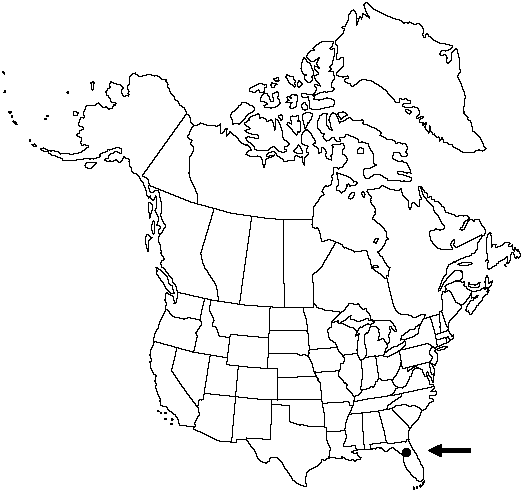Difference between revisions of "Asplenium ×curtissii"
Bull. Torrey Bot. Club 33: 194. 1906.
FNA>Volume Importer |
imported>Volume Importer |
||
| (7 intermediate revisions by 2 users not shown) | |||
| Line 17: | Line 17: | ||
}}<!-- | }}<!-- | ||
| − | --><span class="statement" id="st- | + | --><span class="statement" id="st-undefined" data-properties=""><b>Roots </b>proliferous. <b>Stems</b> erect, unbranched; scales blackish throughout, narrowly deltate, 1 × 0.2 mm, margins entire. <b>Leaves</b> monomorphic. <b>Petiole</b> brownish black, 3–10(–15) cm, 1/3–2/5 length of blade; indument of blackish, narrowly lanceolate scales at base. <b>Blade</b> oblong-lanceolate, 2-pinnate, 10–30 × (1.5–)5–10 cm, thin, glabrous; base not or only slightly tapered; apex gradually narrowing, not rooting. <b>Rachis</b> blackish to green, dull, nearly glabrous. <b>Pinnae</b> in (7–)14–22 pairs, oblong; medial pinnae 1–6 × 0.5–1.5 cm; base truncate; apex pointed. <b>Pinnules</b> linear to fan-shaped to unequally pinnate, 3–9 × 1–7 mm, mostly notched apically. <b>Veins</b> free, evident. <b>Sori</b> 1–4 per segment, usually more on acroscopic side. <b>Spores</b> abortive. <b>2n</b> = 108.</span><!-- |
-->{{Treatment/Body | -->{{Treatment/Body | ||
| Line 23: | Line 23: | ||
|elevation=0–50 m | |elevation=0–50 m | ||
|distribution=Fla. | |distribution=Fla. | ||
| − | |discussion=<p>Asplenium × curtissii, sterile and with irregular meiosis, is the product of hybridization between A. abscissum and A. verecundum and occurs with them in central Florida, sometimes forming large colonies by root proliferation. It can readily be separated from A. abscissum by its pinnate blades. From A. verecundum it can be distinguished by its relatively long petioles and less divided blades. Asplenium × curtissi is known only from several localities in north central Florida. It makes a showy conservatory plant.</p> | + | |discussion=<p><i>Asplenium</i> × <i>curtissii</i>, sterile and with irregular meiosis, is the product of hybridization between <i>A. abscissum</i> and <i>A. verecundum</i> and occurs with them in central Florida, sometimes forming large colonies by root proliferation. It can readily be separated from <i>A. abscissum</i> by its pinnate blades. From <i>A. verecundum</i> it can be distinguished by its relatively long petioles and less divided blades. <i>Asplenium</i> × curtissi is known only from several localities in north central Florida. It makes a showy conservatory plant.</p> |
|tables= | |tables= | ||
|references= | |references= | ||
| Line 32: | Line 32: | ||
-->{{#Taxon: | -->{{#Taxon: | ||
name=Asplenium ×curtissii | name=Asplenium ×curtissii | ||
| − | |||
|authority=Linnaeus | |authority=Linnaeus | ||
|rank=species | |rank=species | ||
| Line 46: | Line 45: | ||
|publication year=1906 | |publication year=1906 | ||
|special status= | |special status= | ||
| − | |source xml=https:// | + | |source xml=https://bitbucket.org/aafc-mbb/fna-data-curation/src/2e0870ddd59836b60bcf96646a41e87ea5a5943a/coarse_grained_fna_xml/V2/V2_313.xml |
|genus=Asplenium | |genus=Asplenium | ||
|species=Asplenium ×curtissii | |species=Asplenium ×curtissii | ||
| − | |||
| − | |||
| − | |||
| − | |||
| − | |||
| − | |||
| − | |||
| − | |||
| − | |||
| − | |||
| − | |||
| − | |||
| − | |||
| − | |||
| − | |||
| − | |||
| − | |||
| − | |||
| − | |||
| − | |||
| − | |||
| − | |||
| − | |||
| − | |||
| − | |||
| − | |||
| − | |||
| − | |||
| − | |||
| − | |||
| − | |||
| − | |||
| − | |||
| − | |||
| − | |||
| − | |||
| − | |||
| − | |||
| − | |||
| − | |||
| − | |||
}}<!-- | }}<!-- | ||
-->[[Category:Treatment]][[Category:Asplenium]] | -->[[Category:Treatment]][[Category:Asplenium]] | ||
Latest revision as of 20:22, 5 November 2020
Roots proliferous. Stems erect, unbranched; scales blackish throughout, narrowly deltate, 1 × 0.2 mm, margins entire. Leaves monomorphic. Petiole brownish black, 3–10(–15) cm, 1/3–2/5 length of blade; indument of blackish, narrowly lanceolate scales at base. Blade oblong-lanceolate, 2-pinnate, 10–30 × (1.5–)5–10 cm, thin, glabrous; base not or only slightly tapered; apex gradually narrowing, not rooting. Rachis blackish to green, dull, nearly glabrous. Pinnae in (7–)14–22 pairs, oblong; medial pinnae 1–6 × 0.5–1.5 cm; base truncate; apex pointed. Pinnules linear to fan-shaped to unequally pinnate, 3–9 × 1–7 mm, mostly notched apically. Veins free, evident. Sori 1–4 per segment, usually more on acroscopic side. Spores abortive. 2n = 108.
Habitat: Shaded damp limestone rocks
Elevation: 0–50 m
Discussion
Asplenium × curtissii, sterile and with irregular meiosis, is the product of hybridization between A. abscissum and A. verecundum and occurs with them in central Florida, sometimes forming large colonies by root proliferation. It can readily be separated from A. abscissum by its pinnate blades. From A. verecundum it can be distinguished by its relatively long petioles and less divided blades. Asplenium × curtissi is known only from several localities in north central Florida. It makes a showy conservatory plant.
Selected References
None.
